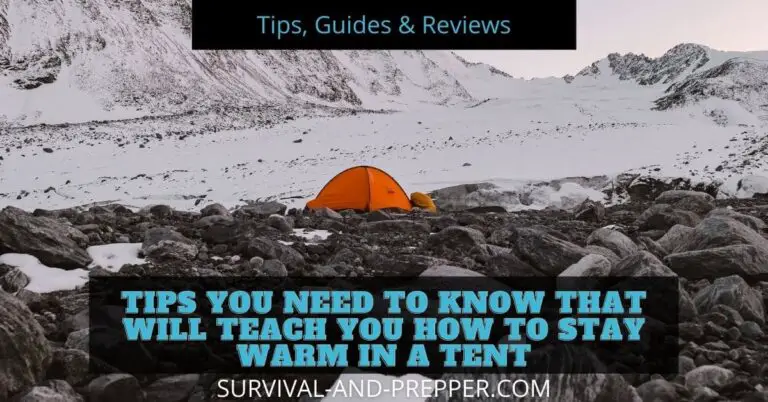15 Tips Recommended By Experienced Preppers That Every Beginner Should Know
Many beginning preppers find themselves overwhelmed by all of the information out there. They often begin prepping by simply buying up everything they can that looks tacticool and says it lasts forever on a shelf.
However, oftentimes they miss some simple things in their preps. Supplies they need, supplies they don’t need, how they are going to carry it and can they carry it. All of these are even more questions to add to the long list.
Here are 15 things suggested by experienced preppers that beginning preppers should think about when beginning their journey.
Make sure to consider the weight of your bug-out bag.
A general rule of thumb many people suggest is no more than 20-30% of your body weight. Make sure to test this weight out and practice with it a bit to get a feel if it is appropriate or too much. One way you could reduce weight is to separate items depending on likelihood of use, or time length of bugging out.
Keep a detailed inventory or supplies and expiration dates.
When you start storing things for the long term, and especially if you are keeping multiple stockpiles in different locations, an inventory becomes critical.
If you have a storage cache at your bug out location then you can’t just walk in and see what you have on hand. A list is needed for this, a detailed inventory and expiration list can also help you with knowing what you should seek out and purchase and if there are any items you need to add into rotation to use them up before they spoil.
A preppers storage list can not only help you keep track of what you have, but if properly used to tell what you need to buy and when you should rotate those items it can also save you money and make sure that your supplies are always in top shape.
Rotate food supplies and other perishable items such as animal feed.
Oftentimes people may remember to rotate their food supplies, which is nothing more than ensuring to use up the oldest stuff first.
However, they frequently forget to rotate other items such as fuels, animal feeds, seeds and even some other items.
Rotating these items is just as important as they will degrade over time.
Develop a plan and tackle one area at a time.

Many people find it difficult to begin preparing for a disaster or major event because they simply do not know where to begin, or the task seems overwhelming.
Experienced preppers will tell you this can be combated by coming up with a plan. Choose the event you are prepping for, say a power outage that lasts for two weeks. Now what are you going to need to get through that.
A generator? Candles? Batteries? Decide on your course of action and break that down into steps. For instance I am going to use a battery powered lantern for my light source for those two weeks. Well my lantern uses a set (4) of batteries every three days meaning I will need a total of 14D/3*4= 20 batteries rounded up. If I also want 1 bottle of fuel for every 7 days then I need 2 bottles of fuel.
With the desired goals in mind I have to decide if I can buy all of those items at once or split up the purchase. Perhaps I will buy 1 bottle of fuel and 10 batteries this month and the rest the following month. While the purchase this month does not allow me to handle the full two weeks, by purchasing some of each supply I can handle a shorter outage with ease.
Take this approach with each of your preps and break them into bite sized chunks that you can add to over time instead of trying to do it all at once.
Have a plan for the items you are storing.
When prepping it is important that you don’t simply store everything you can get your hands on. Unless you have a walmart sized storage room you will quickly run out of space.
Sit down and consider everything you use in one month. That is your starting point. Now consider those things that allow you to get through every day. Power, water, entertainment, gas for your vehicle, the clothes you wear, cooking methods and so on. Make sure to look beyond just the food you need to survive for a month.
Now write down all of these items and possible things you can substitute in to meet those needs.
Now you have the basic plan for what you need. Start storing items to meet those needs. Don’t store things that do not fit into the plan. Don’t buy foods that you don’t eat just because and don’t stock up on things you hope to trade for what you need. Simply stock the items you need in the first place. If you need them then it is almost a certainty that in an emergency someone else would need them as well should you want to trade.
Do not store items you won’t use.
One of the strangest things I have seen is when people store items just because they are available and not because they plan on using them.
While it is possible that storing alcohol and tobacco could be a great trade commodity, I would much prefer to store items that me or my family would actually use. A few extra sets of clothing, or additional food and water would be of far more use to us.
Having items on hand just hoping someone comes by with what you need and is willing to trade for it seems a bit of a far fetched hope, when I could have simply prepared for that need myself instead.
Prep for your needs not someone else’s. One size doesn’t fit All
Time and time again I see people saying you need this or that in your stockpiles. While some items are key what is best for that person may not be the best for everyone.
For example I see people all the time stating that they are going to stockpile a ton of tobacco and cigarettes to use as trade goods. While this could be beneficial I think you should stockpile the items you actually need and then you won’t have to rely on someone else coming by to trade and hoping they want cigarettes.
One way you can determine your needs is to actually do a trial run. Pick whatever event you are preparing for and roleplay it having begun. Act as if the SHTF and you need to put your plan into motion. If possible you should set aside a week minimum for this and two weeks if possible.
For the duration of this only use those supplies you have stockpiled, this includes avoiding the use of power, ac etc if that is something that you would lose in your particular event. Keep a spreadsheet of everything you use, and any time you need to step outside of your preps for something you did not think of.
While this is not a 100% fool proof way to plan, it is a far more realistic look at what “YOU” will need in your preps and not simply what someone else has told you to do.
Consider threats to your food stores.
When storing your foods, take into account potential problems or pests that could destroy your food supplies. This could be anything from loss of refrigeration if you are relying on frozen foods to package damage by mice or other rodents. Take needed steps to avoid these issues. Check out this article on ways your food could become contaminated.
Consider the foods you store based on what you eat, and nutrition, not just price.
Often you see people stockpiled tons of foods that very few people like to eat. Make sure that the stuff you are stockpiling is stuff you one know how to prepare, two have the means to prepare in an emergency, and finally are willing to eat.
Storing 20 cans of asparagus if you don’t eat asparagus is just silly. You can use that space and money for foods that you will actually eat.
Yet again don’t stock up on stuff in the hopes of trading for something else, stock what you will use. You can always trade some of that if you discover you’re missing something.
Consider multiple solutions for a single problem before determining the best course of action.
When selecting gear, whether it be for a bug out scenario or your main stash try and select items that can serve more than one purpose. Focus on these items first.
This is best done by considering all of the potential problems you might face. Then come up with 3 to 5 solutions or ways you can overcome that problem. After that compare these methods or tools to your list and see how many solutions overlap with each other.
For example you need light, heat and a way to cook. Some examples that might meet each of these needs from one device is a kerosene lamp, candles or a traditional wood fire. While not the most efficient method at any of these each can cover the needs you have in place.
So in this example I would opt for a small hatchet and a fire starting device as the wood fire is the easiest of the methods to replace your supplies on.
Pest prevention through storage. – Buckets, metal cans etc
Pests are one of the greatest dangers to your stockpiles. They can destroy everything from food supplies to clothing and even tents, tarps and straps.
With that in mind it is critical that you take steps to ensure your supplies are safe and protected from these pests which range from insects to rodents and more.
There are endless options for buckets, cans and boxes that you can use to store your supplies. Consider what type of pests frequent your area and choose a method appropriate for them. For example if you have bears that frequent the area around your barn, storing your food in a plastic tote is probably not going to work.
On the other hand, if your pests are primarily moths damaging stored clothing then these same plastic totes might be ideal.
Metal cans are one of my favorite methods as living in Georgia we often have mice problems in rural areas.
Practice the skills you need or plan to use.
I often see people who have planned X Y or Z but yet have never attempted those acts. When was the last time you used that nifty firesteel in your bug-out-bag. What about actually caught fish using the small survival fishing kit you have?
While I know there are some people who practice these skills, many do not and simply bought the items as they seem like a good idea. (They are, but only if you have practiced using them.) Take some time and practice your basic survival skills. Try some weekend camping trips using only items in your bug out bag.
Perhaps practice some skills around the house, instead of lighting the bonfire out back with gas and a lighter, practice better building skills and use tinders etc.
Gardening is another, make sure if you plan to rely on growing food when SHTF that you actually have grown a garden lol.
Do You Bug in or Bug out.
Make sure you have clearly defined in specific circumstances whether you intend to bug in or bug out. If you have no intention on bugging out, then focus all of your efforts on bugging in. There is not much point in having a secondary bug out location if there is no foreseeable reason you would leave your location.
On the same hand if you are about 90% certain that you would bug out in most scenarios then put those mechanisms in place.
Bugging out could be to some remote location or simply to a home in another state that you use to migrate south for winter or flee from hurricanes if you live along the coast, the option is yours.
Check and test equipment periodically.
Similar to how you should rotate food supplies to ensure that they stay fresh, testing your equipment to ensure that it still works is an essential part of prepping.
To minimize the chance of damage to my electronics, I normally store them without batteries. How many times have you found batteries all corroded and the contacts eaten through?
A simple way to avoid this is place the electronics in one plastic ziplock bag and its batteries in a second. Place both of these bags and contents into a third bag and seal it up. That way when you need it everything is together and should be in working order.
Even tools such as wooden handled shovels and rakes for gardening can decay over time whether they are used or not. Come up with a plan to inspect all of your supplies at least once a year with more times for those mission critical items.
Split up stockpiles.
People often split up stockpiles when they are preparing a bug out location. However, you should consider splitting them up even in one location if possible. For instance putting half of your supplies in the basement and half in an outbuilding on the same property helps reduce your chances of a total loss.
If the basement floods, then the supplies in the outbuilding are safe and if the out building burns down then the basement supplies are still available.
By splitting these supplies up you have increased your chances and reduced some of your risk. In a more hostile scenario if someone were to come and forcibly take your supplies there is a chance that you would still have the second stockpile to get you through.
In Conclusion
After reading all of those tips, I should point out that while none of these are set in stone, they are listed here to give you an idea of some of the things you should be considering. Proper planning of things such as food and gear storage, and lists or inventories before you even begin can save you world of pain later on down the road.
Use these tips from experienced preppers to continue on your journey and good luck in your preps. While you are here make sure to sign up for our newsletter to get all of the latest posts.






